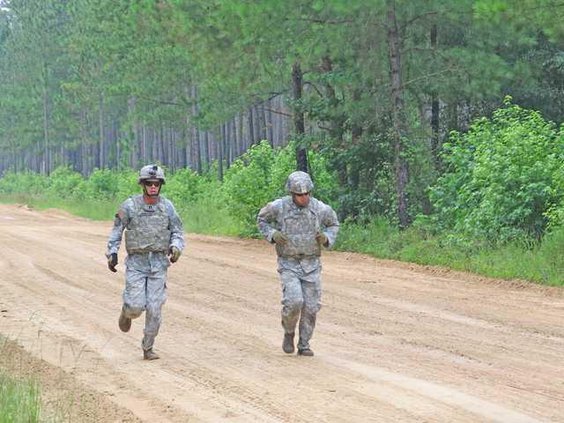For the 3rd Infantry Division’s 2nd Armor Brigade Combat Team, July 14-18 was a week of individual and team competitions. Spartan Week’s athletic battles marked the last time Spartan soldiers will compete or train as a brigade before the unit cases its colors this fall.
On Wednesday, two-man teams competed in a grueling battle-focused triathlon. This competition included 150 pushups and 150 sit-ups, a 1-mile run in full body armor and pulling a 180-pound Sked rescue stretcher to the firing line, then shooting the M500 shotgun, M9 pistol and M4 rifle.
The timed event tested soldiers’ physical strength and endurance as well as their marksmanship skills, said Capt. Caley Langenwalter, commander of B Company, 1st Battalion, 30th Inf. Regt.
When the brigade is inactivated later this year, Langenwalter’s battalion will stay at Fort Stewart with nearly all of its companies being reassigned to the 3rd ID’s 4th Infantry Brigade Combat Team. Spartan Brigade public-affairs officer Capt. Gina Goris said the 1st Battalion, 64th Armor Regiment also will remain with the 3rd ID. The soldiers in the brigade’s four remaining battalions will be reassigned to other Army units, she said.
The first team to attempt the triathlon was Langenwalter and one of his rifle platoon leaders, 1st Lt. Corey King. With Sgt. Andrew Bohman keeping count, King tackled the pushups. He did 25 repetitions, then his company commander did 25 repetitions. They continued doing 25 repetitions each until they’d done a total 150 pushups. Without a break, they went straight into the sit-ups.
After completing 150 sit-ups, they drank some water as they donned their body armor, helmet, eye armor (sunglasses) and gloves. Then they were off at a good pace for the 1-mile run. Seconds later, three more teams followed them up the muddy road leading from Small Arms Range Lima.
The solders’ return-trip pace was not as brisk. The previous event and running in battle gear was starting to wear them down. Most teams used the remaining 100 meters as a cool-down opportunity to walk before grabbing the reins on the Sked — commonly referred to as a Skedco — and dragging it about 100 feet to the first firing lane.
The shotgun was fired at skeet disks mounted on stakes. The targets for the pistol were colored balloons. Targets for the M4 — which had to be engaged from the standing, kneeling, sitting and prone positions — were blue, green or red shapes on a large board 25 meters downrange.
Langenwalter said there were laminated cards at the M4 firing lane that told the soldier the specific target to shoot in each firing position. The card might say, “Shoot green circle,” but the word “green” might be written in red, something a tired marksman might not notice and end up shooting the red circle instead.
“I would say that dragging the Skedco was physically the hardest,” Langenwalter said, also noting the body armor made it difficult to breathe. “When you grab that Skedco after that mile run — I know it’s supposed to weigh 180 pounds, but it felt like 300.”
Langenwalter and King’s total time was about 22 minutes, but due to missed shots during the stress shoot, their time was 24.4 minutes. Nonetheless, the two officers had the best overall time and won the triathlon.
Langenwalter said it didn’t matter if the soldier teams pushed themselves to their limit with the pushups and sit-ups then the run or dragging the Sked. He said if their heart rates were too high, their marksmanship would suffer.
He said if they shoot too fast they wouldn’t hit anything, but if they took time to aim carefully during each shot, their overall time would be affected.
Pfc. Jonathan Hampton agreed with his company commander about the Sked being the most difficult part of the competition. He said he and his teammate had fun, though. The young rifleman said they were the lowest-ranking soldiers competing, so they didn’t “talk trash” to the other teams during the competition.
“(Spartan Week) breaks up the monotony, and you still get something out of it,” Hampton said, calling the triathlon “a smoker.” “It’s not like normal physical training, but it’s good competition that pushes you a little harder. You’re more challenged to shoot straight when you’re completely tired.”
As another unit prepared to start the triathlon, Langenwalter took a moment to reflect on the friendly competition and his brigade’s soon retirement.
“Our battalion, for the most part, we’re all staying together, and that’s a good thing,” he said. “I work a lot with other company commanders across the brigade. Having to see them shut their companies down — that’s the bitter part.”
He said Spartan Week was good for the soldiers and their families because their duty day began a little later each day, which allowed soldiers to spend more time with their families. Families also came out to take part in Friday’s competitions, which included a family obstacle course, he said. Allowing family members to hang out with their soldier was another good thing, he said, because it reminded Spartan warriors of the pride they still had in their unit.
2nd ABCT soldiers compete in Spartan Week's athletic battles


Sign up for our e-newsletters